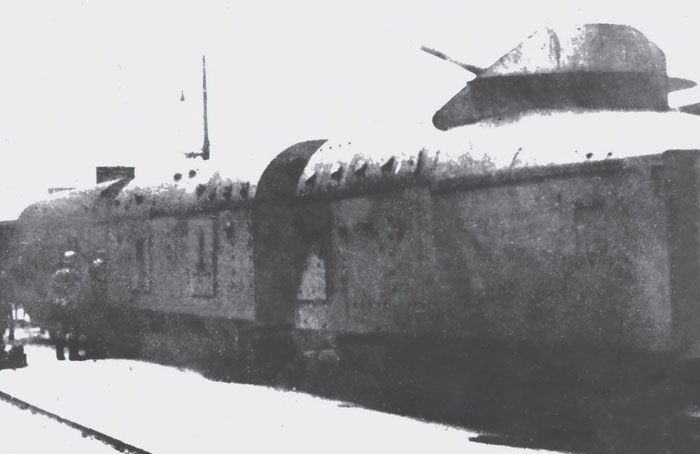
Yugoslavia was created by the Treaty of Versailles2 and broke up in 1992. In order to correctly allocate the armoured trains, this chapter will cover the Yugoslav trains up to the officially recognised disappearance of this state. Because of the various territorial partitions and accidents of history which affected the state of Yugoslavia, the Croatian armoured trains of the Independent State of Croatia (1941–5) and of the Croatian War of Independence (1991–5), plus the Serb armoured trains of the Republica Srpska3 (situated in Bosnia-Herzegovina) and the Serbian Republic of Krajina4 (situated in Croatia) are described separately.
At the end of the First World War, it appears that only the Austro-Hungarian PZ V remained on the territory of the future Yugoslavia. It was taken over by the new Yugoslav Army, although no details of its use have come to light, apparently together with the artillery wagon from PZ I – but the only proof that this wagon was in Yugoslav hands is the photographic record. In March 1921 the French Military Attaché reported that ‘3 or 4 armoured trains could be formed’. On 27 October 1936, the new establishment of the Yugoslav Army included them in its ‘special combat equipment’. However, there is no proof that these armoured trains had actually been put into service. At the time of the German invasion, several wagons were captured in Belgrade and from November 1941 were added to PZ 25. In addition, the pilot wagon of the ex-Austro-Hungarian PZ I was put back into service by the Wehrmacht, only to be lost on some unknown date.

Yugoslav armoured train captured in Belgrade in 1941. Note the modification to the wagon originally part of PZ V which now appears to have been fitted with a turret, possibly for anti-aircraft defence.
(Photo: Wolfgang Sawodny Collection)
Two views of the armoured artillery wagon from the old ex-Austro-Hungarian PZ I, left behind in Yugoslavia after 1918, fitted with buffering gear and brake hoses, and put back into service after the German invasion of Yugoslavia. Note that its 7cm gun has been removed: the wagon is now armed with an MG34.
(Photos: Paul Malmassari Collection)
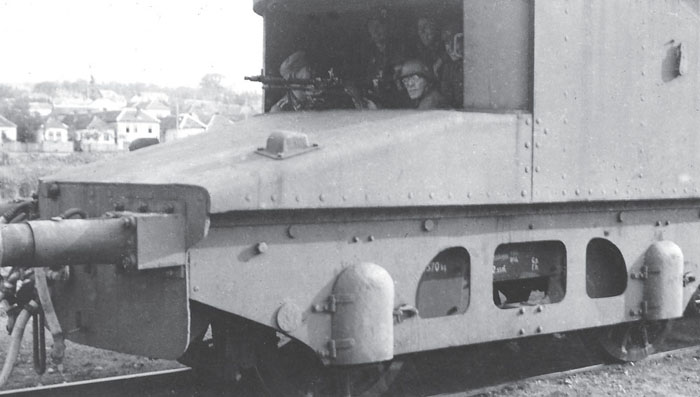
During the Second World War, there were reports of a ‘partisan armoured train’, today preserved in the Narrow Gauge Railway Museum in Požega, situated in the Belgrade-Bar administrative district. It was used in the region of Uzice before that area was retaken by the Wehrmacht.
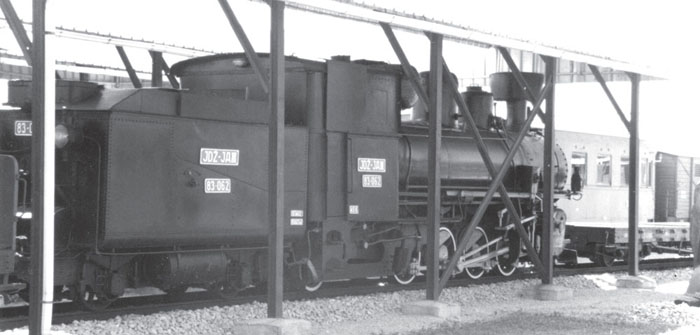
These two photos show the locomotive, on which only the cab is armoured, and a bogie low-sided wagon filled with sand, protecting a central open space. The collection also includes an armoured covered wagon with the same type of firing loopholes.
(Photos: Philippe Tomatis)
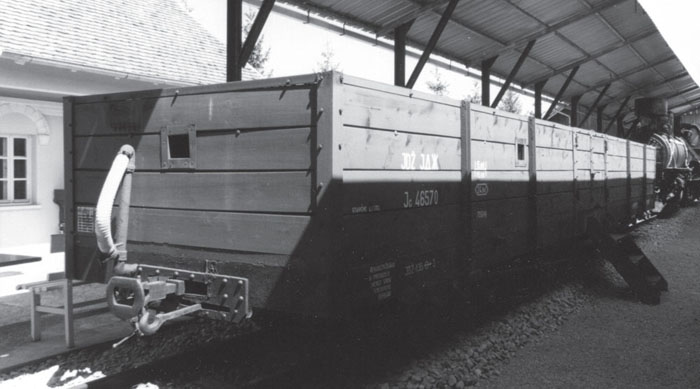
At the end of the Second World War a number of Croatian, German and Italian armoured trains and trolleys were captured, and some at least were put back into service.5 The majority of the units had been seized in Slovenia, and for the first year of the post-war period, they remained either in the zone where they had been captured, or otherwise were stored at the VTZ6 ‘21 October’7 in Kragujevac. On 24 May 1946, General Koca Popovic, Chief of the General Staff, gave orders to the commanders of the armoured and motorised units (KTJM8), to place all the various scattered armoured rail units under the responsibility of the RVK,9 to report back on the numbers of units extant, and to evaluate their current state in order to establish a repair and maintenance programme. At that stage, in the zones of the First, Second, Fourth and Fifth Armies it was reported there were in existence a total of 242 armoured wagons and three armoured locomotives. However, of these some 60 per cent were unusable.
At the VTZ in Kragujevac alone there were around a hundred armoured wagons of which forty had concrete armour. After months of work at the VTZ, thirteen Steyr (in Serbian, Štajer) light trolleys (le.Sp) were considered ready for use along with seven Fiat trolleys. The VTZ also had several examples of heavy trolleys (s.Sp) and Italian LibLi (Ansaldo Fossati ALn56) railcars.
In August 1946 these units were sent to the central armoured workshops (CTR10) to be fitted with the equipment they lacked, notably machine guns and radios. It was planned to form one squadron of light Steyr trolleys,11 then a second one with Fiat AB 41 trolleys. The towed armoured units were to be used by the Army battalions as command wagons, as troop transports or as workshops. At Sarajevo, where eighty-nine armoured wagons were concentrated, sixteen were selected to form a batallion for use on the narrow (76cm) gauge, with six wagons in combat configuration and the remainder in a support role. On the other hand, three armoured locomotives were transferred back to civilian use, as it was planned to use the Steyr trolleys as tractor units for the Narrow Gauge trains. In order to put the units in hand in a fit state to use, the KTMJ decided to cannibalise obsolete units and to produce or purchase the equipment which was missing. The batallions of armoured trains were to be attached to the Third, Fourth and Sixth Armies. The first formation was to be established at Sremska Kamenica.12
The General High Command issued a notice which indicated that the armoured trains had as their ‘principal mission to ensure transport, communications security and combat on the internal front’. It also laid down, however, that no new trains were to be built, and that repairs to existing trains should be carried out only where the end result justified the effort. Lastly it ordered the KTJM to constitute three narrow-gauge (76cm/30in) divisions at Belgrade (or Karlowitz), Zagreb and Sarajevo. The fate of the units in excess of these requirements (seventy-three wagons at Sarajevo, thirty-seven at Kragujevac and an undisclosed number at the VTZ ‘21st October’) was to be decided by the Transport Ministry. No record exists, however, to prove that these armoured trains were ever formed, or that the proposed organisation had been set in motion. On the other hand, in July 1949 armoured trains featured in the inventory of the People’s Corps for the Defence of Yugoslavia (KNOJ13) and were deployed in four divisions for the purposes of internal security:
7th Division: two armoured trains made up of Fiat trolleys at Bosanski Samac and Bihac; two Steyr trolleys at Banja Luka.
11th Division: one platoon at Nis; two armoured trains made up of Steyr trolleys at Skopje.
27th Division: one platoon of three Steyr armoured trains at Batajnica.
16th Division: one Steyr platoon at Vinkovci; three Fiat armoured trains at Ljubljana, Ogulin and Zagreb.
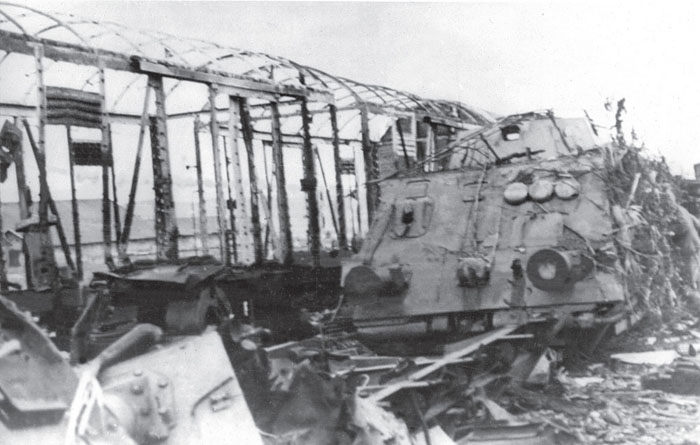
PanzerZug (s.Sp) 201 destroyed in Cacini Station on 14 April 1945. Several of these heavy trolleys were recovered in working order by the new Yugoslav Army.
(Photo: MRN via Bojan Dimitrijević)
In 1950, an article in the Chicago Daily Tribune described ‘several armoured trains … One of which was on a storage siding outside Belgrade … ’.14 In 1953, the KNOJ was dissolved and the armoured train units were integrated into the Yugoslav armoured forces, where the Department of Armoured and Motorised Units was charged with drawing up the doctrine for their emplyment. As the result of this reorganisation, the armoured trains were integrated into the various divisions as follows:
17th OKD:15 two armoured trains, one made up of five Steyr trolleys (three artillery and two MG units), and the other of three Steyr trolleys (two artillery and one MG units) based at Batajnica.
20th OKD: three Steyr trolleys (MG units) at Zagreb; two Fiat trolleys at Ljubljana.
26th OKD: three Fiat trolleys (including one without armament) at Nis (transferred to Batajnica in November 1953 in exchange for three Steyr trolleys); two Steyr trolleys (MG units) at Pristina; two Steyr trolleys (MG units) at Skopje.
In the 7th Military Region (Bosnia-Herzogovina and Montenegro, where no armoured divisions were stationed): six Steyr trolleys (MG units) equally divided between Sarajevo, Banja-Luka and Vinkovci. These latter units would eventually rejoin the 20th OKD in the 5th Military Region.
In mid-October 1954, the armoured trains were gathered together in Zagreb East Station, and on 22 November 1955 the order was given to withdraw all the armoured trains from active service. Their armament and motors were taken out and stored, the armaments at Zagreb (at VR16 No 69) and the motors at the TRZ17 at Bregana. Two years later, on 22 October 1957, it was decided to restore an s.Sp heavy trolley (the 75mm gun version) to working order, using the services of the armoured forces and the Army technical department. However, the lack of spare parts, and the recent manufacture of more modern arms and equipment, led to the abandonment of the project. All the armoured rail units were therefore scrapped.
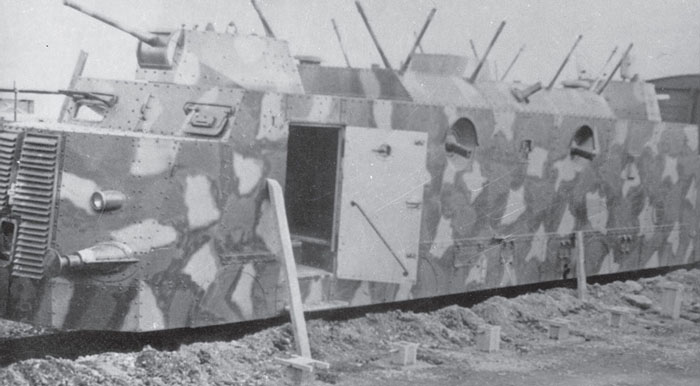
One of the seven LiBli armoured railcars (known as Panzertriebwagen) Nos 30 to 35 and 38, captured in Slovenia in May 1945.
(Photo: MRN via Bojan Dimitrijević)
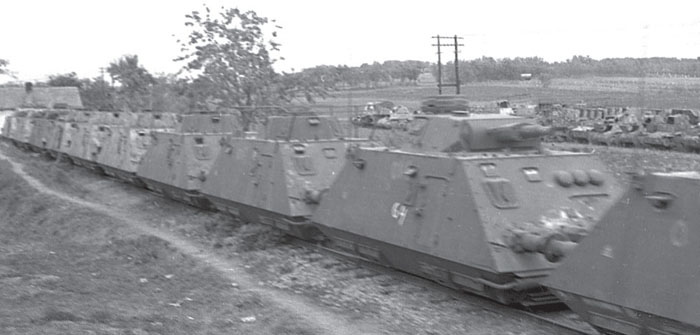
The first of three photos of captured German vehicles integrated into the Yugoslav armoured train units. Above is an alignment of ten s.Sp trolleys, of which at least four have a turret, photographed from a train passing in front of the CTR at Mladenovac, 56km (35 miles) to the south of Belgrade in 1946. Note the line of tanks in the background, among which are former French armoured vehicles.
(Photo: Bojan Dimitrijević Collection)
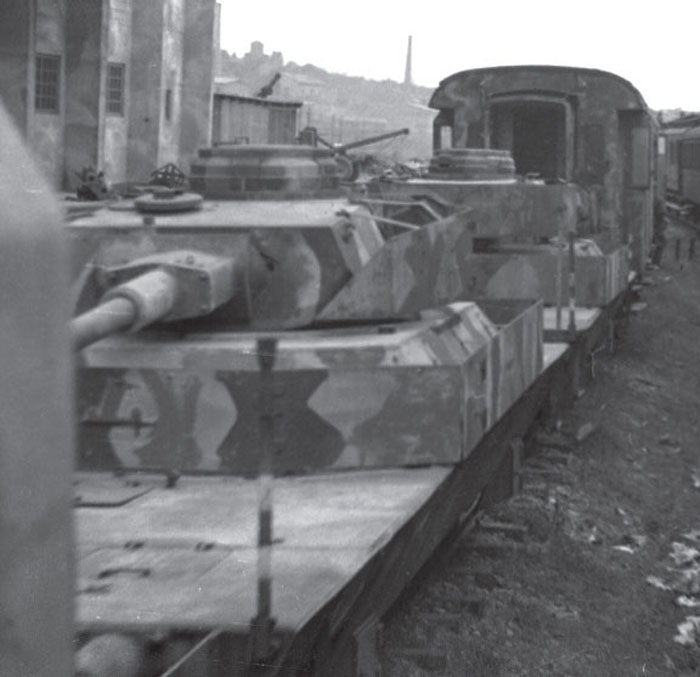
Two PanzerJägerWagen preceded by a Croat wagon.
(Photo: Bojan Dimitrijević Collection)
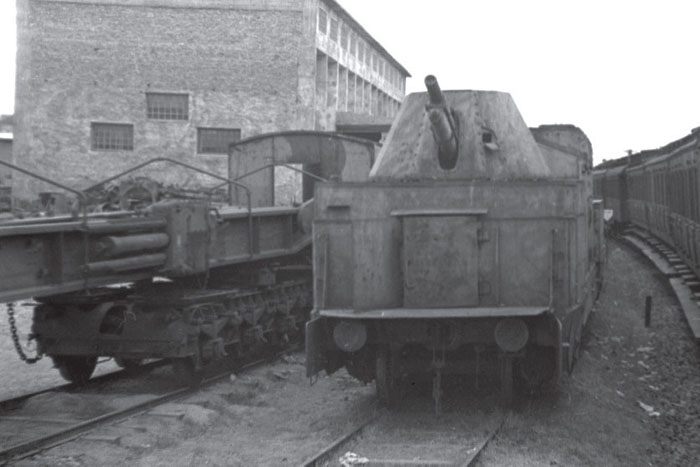
A German armoured artillery wagon with its distinctive turret. The Yugoslav Army was not interested in the complete armoured trains. In comparison the autorails and trolleys were felt to be more useful.
(Photo: Bojan Dimitrijević Collection)
SOURCES:
Archives:
SHD DAT 7 N 3200, 7 N 3202.
Books:
Dimitrijević, Bojan, Modernizacija i intervencija, Jogoslovenske oklopne jedinice 1945-2006 (Belgrade: Institut za savremenu istoriju, 2010).
________________ (with Savić, Dragan), German Panzers and
Allied Armour in Yugoslavia in World War Two (Erlangen: Tankograd Publishing, 2013).
Journal article:
Grognet, Olivier, ‘Les musées ferroviaires yougoslaves’, La Feuille, AJECTA newsletter No 87 (December 1997), pp 5–6.
1. In Serbian: Oklopni Voz, OKV.
2. The Principality of Serbia was created in 1815 and became independent from the Ottoman Empire in 1878. The Kingdom of Serbia was proclaimed in 1882, and then in 1918 the gathering of the Southern Slavs gave birth to the Kingdom of the Serbs, Croats and Slovenes, which became the Kingdom of Yugoslavia in 1929. During the Second World War its territory was divided up by the Axis powers, then in 1945 its territorial integrity was re-established as the Federativna Narodna Republika Jugoslavija or FNRJ (Federal People’s Republic of Yugoslavia). Following the war of 1991 to 1995, then the subsequent independence of Montenegro in 2006, Serbia inherited what was left of the old Yugoslavia.
3. Unilaterally declared in May 1992 and officially recognised within Bosnia-Herzegovina on 14 December 1995 by the Dayton Accords.
4. The ‘Autonomous Serb Region of Krajina’ seceded on 1 April 1991, transformed itself into the ‘Serbian Republic of Krajina’ on 19 December 1991, and was completely overrun by the Croats in early August 1995.
5. For example: PZ (le.SP) 301 at Kraljevo on 11 November 1944, PZ (le.SP) 302 at Kosovo Polje on 12 November 1944, PZ (s.Sp) 201 at Čačincima on 15 April 1945, and PZ 6 destroyed in Serbia on 1 October 1944. At the capitulation the largest number of prizes seized was at Celje and Dravograd (on the Austro-Slovene frontier) when twelve armoured trains and various railcars surrendered, in particular PZ 73 which had been put back into service in the region of Gôrz. An extremely accurate list is given in Bojan Dimitrijevic’s book German Panzers and Allied Armour in Yugoslavia in World War Two.
6. VTZ = Vojno Tehnički Zavod, Military Technical Institute.
7. October 21st could be a reference to the massacre of 21 October 1941, when the German Army killed more than 6000 civilians in reprisal for Chetnik and Partisan actions against them in the area (the number varies according to the sources). It could also be a reference to 21 October 1944, day of the liberation of the city.
8. KTMJ = Komanda Tenkovskih I Mehanizovanih Jedinica.
9. RVK = Rezerva Vrhovne Komande, Reserves High Command.
10. CTR = Centralna Tenkovska Radionica.
11. In reality, the Steyr trolleys were not defined as ‘heavy’ or ‘light’ in the archives, but instead were classified according to their armament. In certain cases it is impossible to be certain which type is mentioned.
12. Today a suburb of Novi Sad.
13. Created on 15 August 1944 to operate in liberated areas.
14. Cass, Donn, ‘Transport Poor in Russia and Balkan Lands’, Chicago Daily Tribune, 3 January 1950, p 4.
15. OKD = Oklopna Divizija, Armoured Division.
16. VR = Vojna Radionica, Military Workshop.
17. TRZ = Tehnicki Remontni Zavod, Technical Repair Workshops.